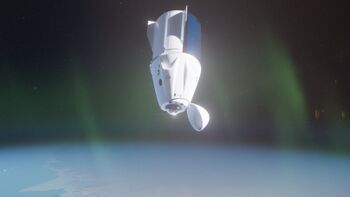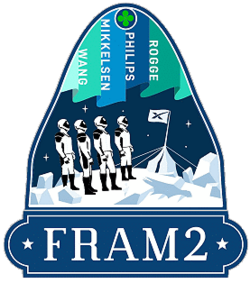Fram2 facts for kids

Artist's rendering of Crew Dragon C207 Resilience during Fram2
|
|
| Mission type | Private spaceflight |
|---|---|
| Operator | SpaceX |
| Mission duration | 3 days, 14 hours and 32 minutes |
| Spacecraft properties | |
| Spacecraft | Crew Dragon C207 Resilience |
| Spacecraft type | Crew Dragon |
| Manufacturer | SpaceX |
| Crew | |
| Crew size | 4 |
| Members |
|
| Start of mission | |
| Launch date | 1 April 2025, 01:46:50 UTC (31 March, 9:46:50 p.m. EDT) |
| Rocket | Falcon 9 Block 5 (B1085‑6), Flight 454 |
| Launch site | Kennedy, LC‑39A |
| End of mission | |
| Recovered by | MV Shannon |
| Landing date | 4 April 2025, 16:19:28 UTC (9:19:28 a.m. PDT) |
| Landing site | Pacific Ocean near Oceanside, California (33°00′N 117°42′W / 33.0°N 117.7°W) |
| Orbital parameters | |
| Reference system | Geocentric orbit |
| Regime | Polar orbit (retrograde) |
| Perigee | 202 km (126 mi) |
| Apogee | 413 km (257 mi) |
| Inclination | 90.01° |
| Period | 93 minutes, 10 seconds |
 Mission insignia |
|
Fram2 was a special space mission. It was a private trip to space, meaning it wasn't run by a government agency. SpaceX operated the mission for a person named Chun Wang. He and his team of three other people flew into a unique orbit. This was the first time humans had ever flown in a polar orbit. During their three-day journey, the crew did important science experiments.
Contents
Meet the Crew
The people who flew on Fram2 were announced in August 2024.
About the Mission
The Fram2 mission focused on studying Earth's poles. It also looked at the space environment around them. The mission used a Crew Dragon spacecraft. This spacecraft had a special panoramic window, like a dome, which was first used on the Inspiration4 mission.
The Spacecraft and Launch
The mission launched from Launch Complex 39A. This launch site is at the Kennedy Space Center. The launch happened on April 1, 2025, at 01:46:50 UTC.
The spacecraft used for Fram2 was named Resilience. It was originally planned to use another spacecraft called Endurance. However, plans changed, and Resilience was chosen instead.
Why "Fram2"?
The mission was named Fram2 because of a famous Norwegian polar exploration ship. That ship was called Fram. The original Fram was the first ship to explore both the North Pole and South Pole. This happened between 1893 and 1912. To honor this history, the Fram2 crew even carried a small piece of the ship's wooden deck into space with them.
Flying Over the Poles
The Fram2 mission entered a low Earth orbit. This orbit took the spacecraft very high, about 413 kilometers (257 miles) at its highest point. Its lowest point was about 202 kilometers (126 miles).
The spacecraft flew in a polar orbit. This means it traveled over both the North and South Poles. It was the first time a human spaceflight mission had done this. The orbit was also a retrograde one, meaning it flew in the opposite direction of Earth's rotation.
Because of this unique flight path, the Dragon spacecraft's software was updated. This made sure that if there was an emergency, the capsule would land safely in the ocean. It would avoid populated areas like Florida, Cuba, Panama, and Peru.
Science in Space
The crew had several science goals. They planned to observe special lights in the sky, similar to the aurora. They also wanted to study green light fragments.
The mission included experiments on the human body. For example, they planned to take the first X-ray of a human in space. The crew also tried to grow oyster mushrooms. These would be the first mushrooms ever grown in space.
One crew member, Rabea Rogge, planned to send images using slow-scan television. These images were for educational groups taking part in an event called Fram2Ham. Rogge also worked on a biological experiment called "Space Genomics."
Landing Back on Earth
The Fram2 mission ended with a splashdown in the Pacific Ocean. This happened off the coast of Oceanside, California. The landing was on April 4, 2025, at 16:19:28 UTC.
This was the first time a Crew Dragon mission landed in the Pacific Ocean. Before, SpaceX cargo missions sometimes landed there. But for astronaut missions, landings usually happened in the Atlantic Ocean. This was to get astronauts back to Kennedy Space Center faster.
However, landing in the Atlantic sometimes caused problems. Parts of the spacecraft, called the trunk module, were supposed to burn up in the atmosphere. But sometimes, pieces were found on land. For the Fram2 Pacific splashdown, the trunk stayed attached longer. It was directed to a very remote part of the ocean called Point Nemo. This area is sometimes called the "spacecraft cemetery." Any debris that survives reentry is unlikely to cause harm there.
See also
 In Spanish: Fram2 para niños
In Spanish: Fram2 para niños
- STS-62-A, a space shuttle mission that was planned to go into polar orbit but was canceled.
- List of fully civilian crewed orbital spaceflights

